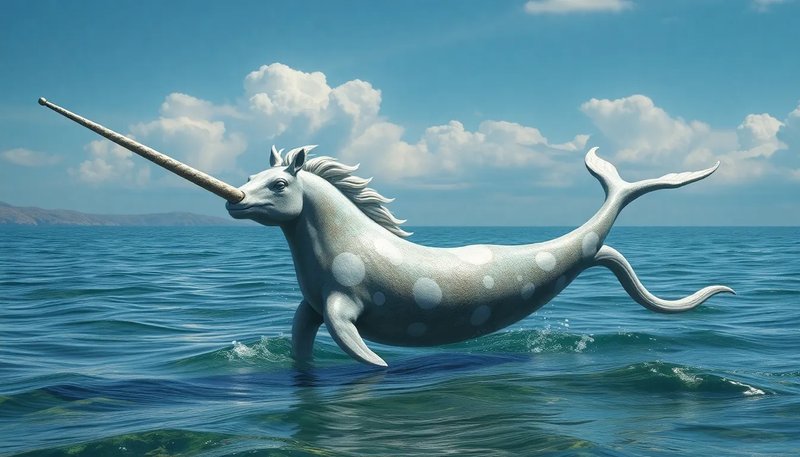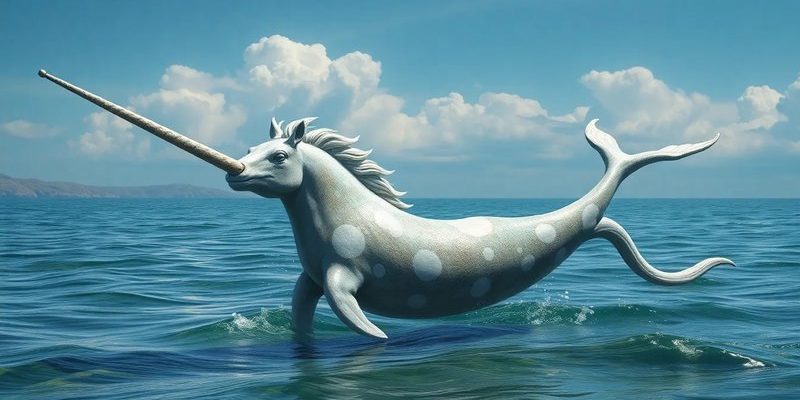
The narwhal, often dubbed the “unicorn of the sea,” has captured the imagination of cultures across the globe. From ancient lore to modern tales, these myths and beliefs shape how we view this enchanting whale. Let’s explore some of the most intriguing stories and cultural significance associated with the narwhal, and uncover the truth behind the legends.
The Narwhal: A Brief Overview
Before we dive into the myths, let’s quickly understand what a narwhal is. Narwhals are medium-sized whales found in Arctic waters, and they’re best known for their remarkable long tusk, which can grow up to 10 feet long. This tusk is actually an elongated tooth, and while it often leads to confusion and fantastical stories, it plays a crucial role in narwhal behavior and social structure.
You might be wondering how these whales have adapted to their icy environment. Well, narwhals have unique adaptations—like their ability to dive deep for food and navigate through ice-covered waters. Their diet mainly consists of fish, squid, and shrimp, all of which contribute to their thriving in the frigid seas. Simply put, narwhals are fascinating creatures that deserve a spot in the spotlight—not just for their looks, but for their role in marine ecosystems.
Myths of the Narwhal
Throughout history, the narwhal has inspired countless myths. Many cultures believed that the narwhal’s tusk possessed magical properties. For early Inuit people, these tusks were seen as powerful items that could be used in medicine or even as talismans against evil spirits.
One widely circulated myth claims that narwhal tusks were the actual horns of unicorns—a delightful fairy tale that still captivates the imaginations of many today. This belief likely stemmed from the rarity of the narwhal and the mysterious allure of the unicorn in European legend. Over time, narwhal tusks were even sold as “unicorn horns” in markets, fetching high prices because of the myths surrounding them.
However, separating fact from fiction can be tough. While it’s clear that the narwhal’s tusk has sparked these legends, the scientific community continuously emphasizes the importance of viewing these beautiful creatures through a lens of conservation rather than myth.
Cultural Significance in Inuit Society
The Inuit people have a deep connection with narwhals, viewing them as both a vital resource and an integral part of their culture. For thousands of years, they have relied on narwhals for food, oil, and materials. Their tusks were used in tools, and their flesh and blubber provided sustenance during harsh Arctic winters.
Celebrations and traditions often revolve around the narwhal hunting season. The arrival of narwhals in the summer symbolizes abundance and brings the community together to share in the preparations for the hunt. Here’s the thing: every part of the narwhal is utilized with respect, showcasing a sustainable relationship with nature that many cultures aspire to today.
It’s also worth noting that stories and legends about narwhals are often shared through songs and oral traditions. These tales not only pass down knowledge about the species but also reinforce the cultural identity of the Inuit people. It’s a beautiful reminder of how the narwhal is more than just a creature of the sea; it’s woven into the cultural fabric of those who inhabit its ecosystem.
Modern Interpretations and Environmental Awareness
As we move into the 21st century, the narwhal is at the center of environmental discussions. With climate change threatening Arctic habitats, these animals face uncertain futures. You might be wondering how this ties back to myths and beliefs. Well, modern interpretations of the narwhal now focus more on conservation and education rather than solely on mystical stories.
Many organizations are working tirelessly to raise awareness about the importance of protecting the narwhal and its habitat. Educational programs highlight not just the enchanting aspects of the narwhal, but also the pressing challenges they face. By fostering a deeper understanding of this incredible creature, we can inspire a new generation to appreciate and protect the narwhal—myths included.
In a way, the modern narrative builds on the myths rather than dismissing them. By understanding the cultural significance of the narwhal, we create a bridge between the past and present, connecting people with this mesmerizing creature in a more meaningful way.
The Narwhal in Art and Literature
The mystique of the narwhal has inspired numerous works of art and literature throughout history. From ancient carvings to contemporary paintings, artists have often depicted the narwhal as a symbol of mystery and beauty.
In literature, the narwhal appears in various forms, from children’s stories to epic poems. It’s often associated with themes of adventure and discovery, intertwining with human fascination for the unknown. Reading about narwhals can transport you to their Arctic home, illustrating the interplay between nature and human imagination.
Moreover, as conservation efforts grow, artists are using their platforms to address critical issues surrounding marine life. By incorporating narwhals into their works, they raise awareness about the need to protect these magnificent creatures and their environment. Art becomes a means to educate and inspire action, creating a powerful narrative that complements the myths surrounding the narwhal.
The narwhal is not just an aquatic anomaly; it serves as a powerful symbol of wonder, mystery, and the delicate balance of our ecosystems. From the enchanting myths that paint them as unicorns to their vital role in Inuit culture, narwhals have a rich tapestry of stories that deserve to be celebrated and understood.
As we learn more about these unique whales and the challenges they face, we can blend the magic of myth with a commitment to conservation. Ultimately, embracing both the stories and the real-world implications of our actions can help protect the narwhal for generations to come. So, the next time you hear about this fascinating creature, remember there’s much more to the story than meets the eye.

